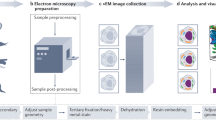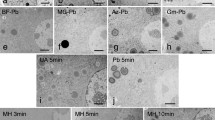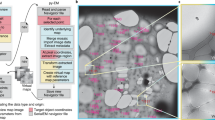Abstract
AUTORADIOGRAPHY combined with light or transmission electron microscopy has become a very valuable tool in biological research1,2. Light microscope (LM) autoradiographic resolution is, however, limited by the resolving power of the optical system. A ten to twenty times improvement in autoradiographic resolution (up to 50 to 70 nm) can be obtained in the transmission electron microscope (TEM) but a number of physical factors limit the system1,2 including the size and the sensitivity of the photographic emulsion silver halide crystal and the grain-size. Further, ultrathin TEM sections limit detection of radioactive material in labelled specimens by the very small fraction of total incorporated radioactivity present in such sections. This leads to a practical limitation of TEM autoradiography for, in addition to the already time-consuming preparation of ultrathin sections, high levels of radioactive labelling and long exposure times (about ten times that of LM autoradiography) must in general be used to compensate for the low efficiency of the procedure.
This is a preview of subscription content, access via your institution
Access options
Subscribe to this journal
Receive 51 print issues and online access
$199.00 per year
only $3.90 per issue
Buy this article
- Purchase on Springer Link
- Instant access to full article PDF
Prices may be subject to local taxes which are calculated during checkout
Similar content being viewed by others
References
Rogers, A. W., Techniques of Autoradiography (Elsevier Scientific Publishing Co., Amsterdam, 1973).
Jacob, J., Int. Rev. Cytol., 30, 91 (1971).
Paul, D., Gröbe, A., and Zimmer, F., Nature, 227, 488 (1970).
Hodges, G. M., Muir, M. D., and Spacey, G., SEM/IITRI, 6, 589 (1973).
Pachter, B. R., Penha, D., Davidowitz, J., and Breinin, G. M., SEM/IITRI, 6, 387 (1973).
Messier, B., and Leblond, C. P., Proc. Soc. exp. Biol. Med., 96, 7 (1957).
Revel, J. P., and Hay, E. D., Expl. Cell Res., 25, 474 (1961).
Metz, H. J., J. Photogr. Soc., 20, 111 (1972).
Mueller, W. E., Photographic Processing (edit. by Cox, R. J.), 285 (Academic Press, London and New York, 1973).
Gross, W., Photographic Processing (edit. by Cox, R. J.) 291 (Academic Press, London and New York, 1973).
Kopriwa, B. M., J. Histochem. Cytochem., 15, 501 (1967).
Price, C. W., and Johnson, D. W., SEM/IITRI, 4, 145 (1971).
Oatley, C. W., The Scanning Electron Microscope, Part I, 153 (Cambridge University Press, 1972).
Gibbard, D., Quantitative Scanning Electron Microscopy (edit. by Holt, D. B., Muir, M. D., Grant, P., and Bosswarva, I.) (Academic Press, London and New York, in the press).
Author information
Authors and Affiliations
Rights and permissions
About this article
Cite this article
HODGES, G., MUIR, M. Autoradiography of Biological Tissues in the Scanning Electron Microscope. Nature 247, 383–385 (1974). https://doi.org/10.1038/247383a0
Received:
Revised:
Issue Date:
DOI: https://doi.org/10.1038/247383a0
This article is cited by
-
Visualization and rapid quantification of autoradiographic labeling in scanning electron microscopy applied to localization of receptor sites on the surface of whole cells
Virchows Archiv B Cell Pathology Including Molecular Pathology (1992)
-
The localization of histochemical and autoradiographic products in the scanning electron microscope by means of atomic number contrast
The Histochemical Journal (1983)
Comments
By submitting a comment you agree to abide by our Terms and Community Guidelines. If you find something abusive or that does not comply with our terms or guidelines please flag it as inappropriate.



